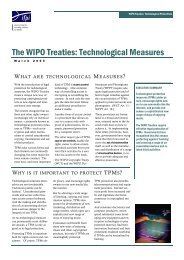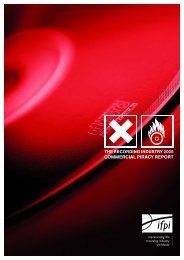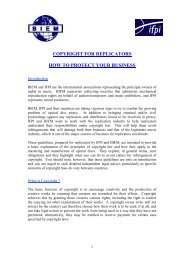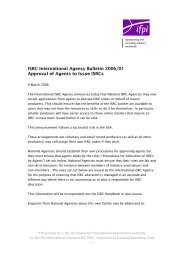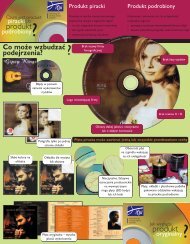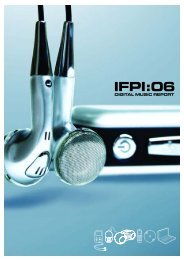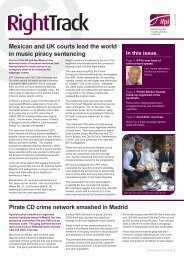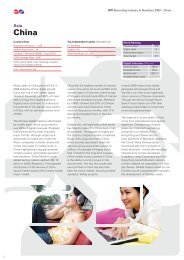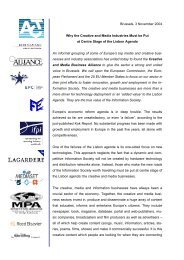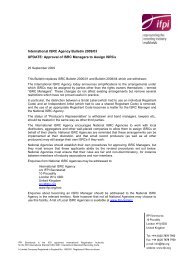WIPO Treaties: Rights Management Information - IFPI
WIPO Treaties: Rights Management Information - IFPI
WIPO Treaties: Rights Management Information - IFPI
You also want an ePaper? Increase the reach of your titles
YUMPU automatically turns print PDFs into web optimized ePapers that Google loves.
The <strong>WIPO</strong> <strong>Treaties</strong>: <strong>Rights</strong> <strong>Management</strong> <strong>Information</strong><br />
Page 2<br />
H OW SHOULD THIS BE IMPLEMENTED?<br />
<strong>WIPO</strong> TREATY TEXT<br />
WPPT Art. 19.<br />
(1) Contracting Parties shall<br />
provide adequate and effective<br />
legal remedies against any person<br />
knowingly performing any of the<br />
following acts knowing, or with<br />
respect to civil remedies having<br />
reasonable grounds to know, that<br />
it will induce, enable, facilitate or<br />
conceal an infringement of any<br />
right covered by this Treaty:<br />
(i) to remove or alter any<br />
electronic rights management<br />
information without authority;<br />
(ii) to distribute, import for<br />
distribution, broadcast,<br />
communicate or make available<br />
to the public, without authority,<br />
performances, copies of fixed<br />
performances or phonograms<br />
knowing that electronic rights<br />
management information has<br />
been removed or altered without<br />
authority.<br />
(2) As used in this Article, ‘rights<br />
management information’ means<br />
information which identifies the<br />
performer, the performance of the<br />
performer, the producer of the<br />
phonogram, the phonogram, the<br />
owner of any right in the<br />
performance or phonogram, or<br />
information about the terms and<br />
conditions of use of the<br />
performance or phonogram, and<br />
any numbers or codes that<br />
represent such information, when<br />
any of these items of information<br />
is attached to a copy of a fixed<br />
performance or a phonogram or<br />
appears in connection with the<br />
communication or making<br />
available of a fixed performance<br />
or a phonogram to the public.<br />
Most countries are finding that<br />
their copyright laws require<br />
some modernising to deal adequately<br />
with the legal protection<br />
of RMI. There are several<br />
elements that governments<br />
and right holders have found<br />
crucial to ensure the effective<br />
legal protection of RMI:<br />
•Definition of RMI. The starting<br />
point is the definition of RMI.<br />
The treaties themselves provide<br />
a clear and useful definition,<br />
which may be useful to<br />
include in implementing legislation.<br />
The definition must include<br />
the required categories of protected<br />
information (information<br />
on works, phonograms<br />
or performances; on the identity<br />
of the author, the phonogram<br />
producer or the performer;<br />
or on the terms and<br />
conditions of use).<br />
It should also indicate that the<br />
information must be attached<br />
to a work, a fixation of a performance<br />
or a phonogram, or<br />
must appear in connection<br />
with any intangible type of use<br />
including the communication<br />
to the public, broadcasting, or<br />
‘making available’.<br />
•Protection against manipulation<br />
of RMI. One of the treaties’<br />
main aims of protection is the<br />
prohibition of manipulation of<br />
RMI. The treaties explicitly<br />
mention the unauthorised removal<br />
and alteration of RMI.<br />
Another type of manipulation<br />
of RMI having equivalent effect<br />
is the unauthorised addition<br />
of information. This activity<br />
can mislead users and businesses<br />
as to permitted uses and<br />
discourage the use of RMI,<br />
just as much as the removal or<br />
alteration of RMI does.<br />
•Protection against dissemination<br />
of copies in which RMI has<br />
been manipulated . The second<br />
main element of protection is<br />
the prohibition of activities<br />
relating to copies as to which<br />
RMI has been removed or altered<br />
without authorisation.<br />
To enable rights owners to<br />
take such copies out of circulation<br />
and prevent further harm,<br />
it is important to provide a<br />
complete list of prohibited activities<br />
including distribution,<br />
export, import for distribution,<br />
broadcasting, communication to<br />
the public, and the making available<br />
to the public of such copies.<br />
•Knowledge requirement regarding<br />
the impact of the activity on<br />
copyright infringement. Activities<br />
relating to RMI need not<br />
lead to legal proceedings if<br />
they have been performed accidentally<br />
and innocently.<br />
The knowledge test established<br />
by the treaties varies depending<br />
on the type of activity. As<br />
regards the removal or alteration<br />
of RMI without authorisation,<br />
the test is whether the<br />
person knew, or in the case of<br />
civil proceedings had reasonable<br />
grounds to know, that<br />
such manipulation would induce,<br />
enable, facilitate, or conceal<br />
infringement of copyright<br />
or neighbouring rights.<br />
As regards the dissemination<br />
without authorisation of content<br />
where RMI has been manipulated<br />
or removed, the test<br />
is whether the person knew<br />
that RMI has been manipulated<br />
or removed, as well as<br />
whether the person knew, or<br />
in the case of civil proceedings<br />
had reasonable grounds to<br />
know, that the dissemination<br />
of content without RMI (or<br />
with manipulated RMI) would<br />
induce, enable, facilitate, or<br />
conceal an infringement.<br />
•Prohibition of ‘watermark washing’<br />
devices. In parallel to the<br />
protection of technological<br />
measures, meaningful protection<br />
against RMI manipulation<br />
and removal should extend<br />
to devices designed or<br />
adapted to manipulate or remove<br />
RMI.<br />
There is a substantial danger<br />
that devices that systematically<br />
'wash out' watermarks while<br />
leaving the content unchanged<br />
will undermine the confidence<br />
of rights owners and legitimate<br />
users, which is essential to the<br />
use of rights management information<br />
in the first place.<br />
The protection required by the<br />
treaties can be achieved best<br />
by also prohibiting the manufacture,<br />
importation, distribution,<br />
offer to the public, provision<br />
or otherwise trafficking in<br />
devices designed or adapted to<br />
manipulate or remove RMI,<br />
and means with equivalent<br />
effect.




